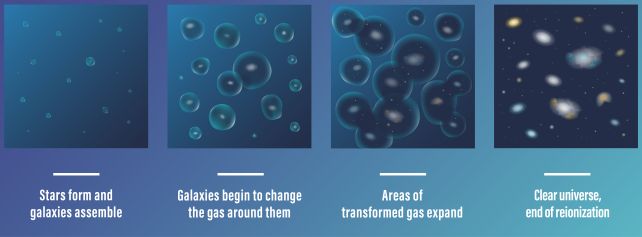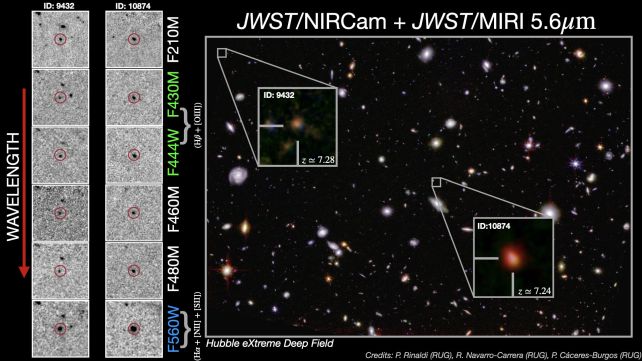
Scientists Witness Birth of Light at the Dawn of Time
Share
In a daring quest to unravel the mysteries of the Universe's birth, scientists have embarked on a journey to glimpse the very first lights that illuminated the cosmos at the dawn of time. Imagine, if you will, a time when the Universe was just a newborn, a swirling cauldron of cosmic potential.
In recent papers published in The Astrophysical Journal, astronomers have made significant progress in understanding the Epoch of Reionization (EoR), a crucial period when the Universe transitioned from being opaque to becoming transparent, allowing light from stars and galaxies to shine through. These new findings were made possible through observations using the James Webb Space Telescope (JWST), providing the deepest insights into this enigmatic epoch to date.
During the early Universe, within the first billion years after the Big Bang, space was filled with a dense fog of ionized gas, making it impenetrable to light. However, as the gas cooled, protons and electrons combined to form neutral hydrogen atoms and some helium in a process known as the Epoch of Recombination, occurring roughly 300,000 years after the Big Bang. This transition allowed light to move freely, but the Universe remained predominantly dark due to a lack of light sources.
 A diagram showing the progress of reionization. (NASA, ESA, CSA, Joyce Kang/STScI)
A diagram showing the progress of reionization. (NASA, ESA, CSA, Joyce Kang/STScI)
The subsequent phase, the Epoch of Reionization, involved the formation of stars from clumps of neutral hydrogen that grouped together to form galaxies. These stars emitted intense ultraviolet light that ionized the surrounding gas by knocking electrons loose. Despite the expansion of space, the newly ionized hydrogen remained diffuse enough to allow light to stream through. By approximately 1 billion years after the Big Bang, space had become completely transparent.
The JWST, specifically designed to study this epoch, has played a crucial role in advancing our understanding. One of the papers describes the first detection of a specific wavelength of hydrogen called hydrogen alpha, which serves as a signature of star formation. The intense ultraviolet radiation emitted by massive young stars ionizes the neutral hydrogen in the interstellar medium, causing it to glow in the hydrogen alpha line. This detection provides a strong clue that star formation played a significant role in the reionization process.

Another paper focused on the non-uniform nature of reionization, revealing that it occurred in pockets or bubbles around the brightest ultraviolet emitters, namely galaxies. Using JWST data, astronomers identified these transparent regions surrounding galaxies and measured their size. This finding highlights the active contribution of galaxies in the reionization process.
A third paper analysed the characteristics of these bubbles and found that the galaxies within them were hot, low in metals and dust, and highly active. These galaxies exhibited more chaotic behaviour compared to those in the present-day Universe, indicating intense star formation and the occurrence of numerous supernovae.
In addition to studying the reionization processes, a fourth paper focused on a quasar galaxy at the centre of the JWST observations. Quasars are exceptionally bright objects, hosting supermassive black holes that accrete large amounts of matter and emit tremendous amounts of light. The analysis of light from this quasar revealed the presence of a supermassive black hole around 10 billion times the mass of the Sun. Understanding how such a massive black hole formed in just 1 billion years poses an intriguing challenge for future research.
While these new findings provide valuable insights into the Epoch of Reionization, astronomers acknowledge that there is still much more to explore and understand. The JWST's capabilities have demonstrated the potential for routine studies of early galaxies, opening up exciting possibilities for further discoveries in this field.
ARSE Jnr
The section where we explain the above to 5-year-olds (and Flat Earthers).
Imagine the Universe as a really big and old place. A long, long time ago, right after the Big Bang, everything was changing very quickly. It was like a hot and foggy soup. The fog was so thick that light couldn't travel through it, so it was really dark.
But then, things started to cool down a bit. At some point, the fog became less thick, and some special atoms called hydrogen and helium started to form. This was called the Epoch of Recombination, which is just a fancy way of saying that the atoms were joining together.
Once the atoms formed, light could move more freely, but there still weren't many things to make light. So, space remained pretty dark for a while.
Then, something interesting happened. Clumps of the hydrogen atoms started to come together and form stars. These stars were like big balls of fire that gave off a special kind of light called ultraviolet light. This light was so strong that it made the hydrogen atoms lose their electrons, which made the gas around the stars glow.
This period is called the Epoch of Reionization. As time went on, more and more stars formed, and their light spread out, making space brighter. After about a billion years, space became completely transparent, and stars and galaxies could shine through.
Scientists have been using a special telescope called the James Webb Space Telescope to study this time in the Universe's history. They have found that star formation played a big role in making space bright, and they have also learned about galaxies and other fascinating things.
There is still a lot more to learn, but these discoveries are helping scientists understand how the Universe turned from being dark and foggy to becoming full of light and stars.
You’ve come this far…
Why not venture a little further into A.S.S. - our exclusive Australian Space Society.
And keep thrusting Australia into the deep unknown…
#Space_Aus




